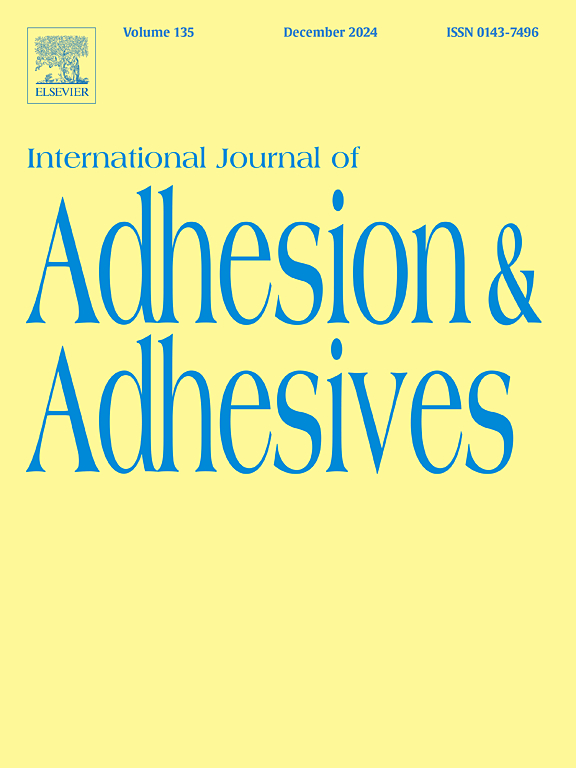优化铝合金的附着力:表面处理和结合强度的跨学科方法
IF 3.2
3区 材料科学
Q2 ENGINEERING, CHEMICAL
International Journal of Adhesion and Adhesives
Pub Date : 2025-05-23
DOI:10.1016/j.ijadhadh.2025.104068
引用次数: 0
摘要
由于铝结构的轻量化和可持续性优势,铝结构的使用越来越多,因此优化粘合技术对于确保坚固耐用的连接至关重要。本研究系统评价了14种用于铝板和l型接头的表面处理方法,评估了它们对粘合性能的影响。表面处理对粘结强度有显著影响。与未经处理的表面相比,纱布砂与西卡®底漆-207相结合,抗拉强度提高了82%,抗剪强度提高了258%。激光和热去离子水处理导致最高的测量表面能(88 mN/m),改善润湿性和粘合剂-衬底相互作用。为分析结构接头的粘接性能,采用柔性聚氨酯胶粘剂对结构接头进行了拉伸和剪切试验。结果表明,表面粗糙度、自由能和化学改性对失效模式有很大影响。虽然未经处理的表面主要表现为粘合破坏,但优化处理将破坏转向内聚破坏,表明界面结合更强。此外,研究了表面自由能、表面粗糙度和粘接强度之间的相关性,以了解它们对接头性能的综合影响。研究结果强调了选择合适的表面改性技术以最大限度地提高附着力和关节耐久性的重要性。该研究为依赖铝键合的行业提供了实际见解,为优化表面处理方案提供了指导,以提高苛刻应用中的结构完整性和长期可靠性。本文章由计算机程序翻译,如有差异,请以英文原文为准。
Optimizing adhesion in aluminum alloys: A cross-disciplinary approach to surface treatment and bond strength
As the use of aluminum structures grows due to their lightweight properties and sustainability advantages, optimizing bonding technologies is essential for ensuring strong and durable joints. This study systematically evaluates fourteen surface treatment methods applied to aluminum sheets and L-section joints, assessing their influence on adhesion performance.
Surface preparation significantly impacted bond strength. Veil sanding combined with Sika® Primer-207 led to an 82 % increase in tensile strength and a 258 % increase in shear strength compared to untreated surfaces. Laser and hot deionized water treatments resulted in the highest measured surface energy (88 mN/m), improving wettability and adhesive-substrate interaction.
To analyze bonding performance, a flexible polyurethane adhesive was applied to structural joints, which were tested under tensile and shear stress conditions. The results demonstrated that surface roughness, free energy, and chemical modification strongly influence failure modes. While untreated surfaces predominantly exhibited adhesive failure, optimized treatments shifted failure toward cohesive failure, indicating a stronger interfacial bond.
Additionally, the correlation between surface free energy, surface roughness, and adhesive strength was examined to understand their combined effects on joint performance. The findings highlight the importance of selecting appropriate surface modification techniques to maximize adhesion and joint durability.
This research provides practical insights for industries relying on aluminum bonding, offering guidance on optimizing surface treatment protocols to enhance structural integrity and long-term reliability in demanding applications.
求助全文
通过发布文献求助,成功后即可免费获取论文全文。
去求助
来源期刊

International Journal of Adhesion and Adhesives
工程技术-材料科学:综合
CiteScore
6.90
自引率
8.80%
发文量
200
审稿时长
8.3 months
期刊介绍:
The International Journal of Adhesion and Adhesives draws together the many aspects of the science and technology of adhesive materials, from fundamental research and development work to industrial applications. Subject areas covered include: interfacial interactions, surface chemistry, methods of testing, accumulation of test data on physical and mechanical properties, environmental effects, new adhesive materials, sealants, design of bonded joints, and manufacturing technology.
 求助内容:
求助内容: 应助结果提醒方式:
应助结果提醒方式:


